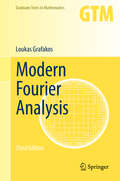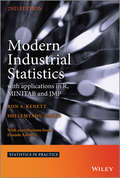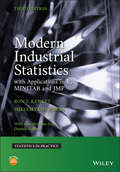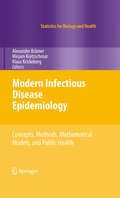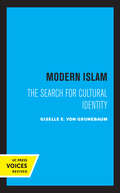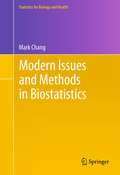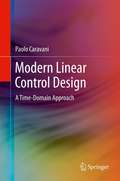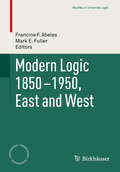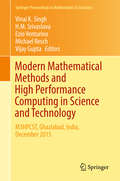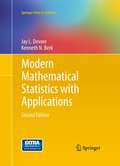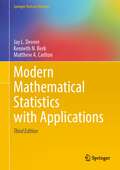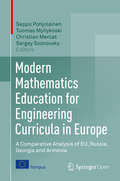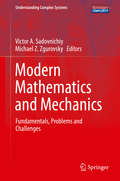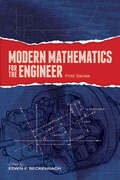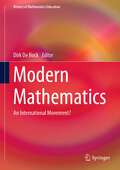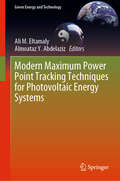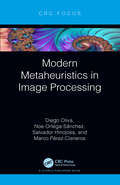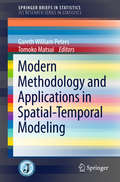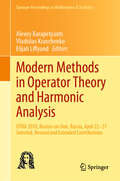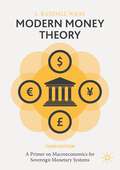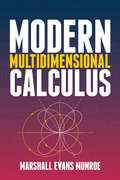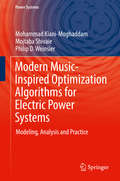- Table View
- List View
Modern Fourier Analysis
by Loukas GrafakosThis text is addressed to graduate students in mathematics and to interested researchers who wish to acquire an in depth understanding of Euclidean Harmonic analysis. The text covers modern topics and techniques in function spaces, atomic decompositions, singular integrals of nonconvolution type and the boundedness and convergence of Fourier series and integrals. The exposition and style are designed to stimulate further study and promote research. Historical information and references are included at the end of each chapter. This third edition includes a new chapter entitled "Multilinear Harmonic Analysis" which focuses on topics related to multilinear operators and their applications. Sections 1. 1 and 1. 2 are also new in this edition. Numerous corrections have been made to the text from the previous editions and several improvements have been incorporated, such as the adoption of clear and elegant statements. A few more exercises have been added with relevant hints when necessary. Reviews from the Second Edition: "The books cover a large amount of mathematics. They are certainly a valuable and useful addition to the existing literature and can serve as textbooks or as reference books. Students will especially appreciate the extensive collection of exercises. " --Andreas Seeger, Mathematical Reviews "The exercises at the end of each section supplement the material of the section nicely and provide a good chance to develop additional intuition and deeper comprehension. The historical notes in each chapter are intended to provide an account of past research as well as to suggest directions for further investigation. The volume is mainly addressed to graduate students who wish to study harmonic analysis. " --Leonid Golinskii, zbMATH
Modern Industrial Statistics
by Shelemyahu Zacks Daniele Amberti Ron KenettFully revised and updated, this book combines a theoretical background with examples and references to R, MINITAB and JMP, enabling practitioners to find state-of-the-art material on both foundation and implementation tools to support their work. Topics addressed include computer-intensive data analysis, acceptance sampling, univariate and multivariate statistical process control, design of experiments, quality by design, and reliability using classical and Bayesian methods. The book can be used for workshops or courses on acceptance sampling, statistical process control, design of experiments, and reliability.Graduate and post-graduate students in the areas of statistical quality and engineering, as well as industrial statisticians, researchers and practitioners in these fields will all benefit from the comprehensive combination of theoretical and practical information provided in this single volume.Modern Industrial Statistics: With applications in R, MINITAB and JMP:Combines a practical approach with theoretical foundations and computational support.Provides examples in R using a dedicated package called MISTAT, and also refers to MINITAB and JMP.Includes exercises at the end of each chapter to aid learning and test knowledge.Provides over 40 data sets representing real-life case studies.Is complemented by a comprehensive website providing an introduction to R, and installations of JMP scripts and MINITAB macros, including effective tutorials with introductory material: www.wiley.com/go/modern_industrial_statistics.
Modern Industrial Statistics: With Applications in R, MINITAB, and JMP (Statistics in Practice)
by Shelemyahu Zacks Ron S. KenettModern Industrial Statistics The new edition of the prime reference on the tools of statistics used in industry and services, integrating theoretical, practical, and computer-based approachesModern Industrial Statistics is a leading reference and guide to the statistics tools widely used in industry and services. Designed to help professionals and students easily access relevant theoretical and practical information in a single volume, this standard resource employs a computer-intensive approach to industrial statistics and provides numerous examples and procedures in the popular R language and for MINITAB and JMP statistical analysis software. Divided into two parts, the text covers the principles of statistical thinking and analysis, bootstrapping, predictive analytics, Bayesian inference, time series analysis, acceptance sampling, statistical process control, design and analysis of experiments, simulation and computer experiments, and reliability and survival analysis. Part A, on computer age statistical analysis, can be used in general courses on analytics and statistics. Part B is focused on industrial statistics applications.The fully revised third edition covers the latest techniques in R, MINITAB and JMP, and features brand-new coverage of time series analysis, predictive analytics and Bayesian inference. New and expanded simulation activities, examples, and case studies—drawn from the electronics, metal work, pharmaceutical, and financial industries—are complemented by additional computer and modeling methods. Helping readers develop skills for modeling data and designing experiments, this comprehensive volume:Explains the use of computer-based methods such as bootstrapping and data visualizationCovers nonstandard techniques and applications of industrial statistical process control (SPC) chartsContains numerous problems, exercises, and data sets representing real-life case studies of statistical work in various business and industry settingsIncludes access to a companion website that contains an introduction to R, sample R code, csv files of all data sets, JMP add-ins, and downloadable appendicesProvides an author-created R package, mistat, that includes all data sets and statistical analysis applications used in the bookPart of the acclaimed Statistics in Practice series, Modern Industrial Statistics with Applications in R, MINITAB, and JMP, Third Edition, is the perfect textbook for advanced undergraduate and postgraduate courses in the areas of industrial statistics, quality and reliability engineering, and an important reference for industrial statisticians, researchers, and practitioners in related fields. The mistat R-package is available from the R CRAN repository.
Modern Infectious Disease Epidemiology
by Mirjam Kretzschmar Alexander Krämer Klaus KrickebergHardly a day goes by without news headlines concerning infectious disease threats. Currently the spectre of a pandemic of influenza A|H1N1 is raising its head, and heated debates are taking place about the pro's and con's of vaccinating young girls against human papilloma virus. For an evidence-based and responsible communication of infectious disease topics to avoid misunderstandings and overreaction of the public, we need solid scientific knowledge and an understanding of all aspects of infectious diseases and their control. The aim of our book is to present the reader with the general picture and the main ideas of the subject. The book introduces the reader to methodological aspects of epidemiology that are specific for infectious diseases and provides insight into the epidemiology of some classes of infectious diseases characterized by their main modes of transmission. This choice of topics bridges the gap between scientific research on the clinical, biological, mathematical, social and economic aspects of infectious diseases and their applications in public health. The book will help the reader to understand the impact of infectious diseases on modern society and the instruments that policy makers have at their disposal to deal with these challenges. It is written for students of the health sciences, both of curative medicine and public health, and for experts that are active in these and related domains, and it may be of interest for the educated layman since the technical level is kept relatively low.
Modern Introduction to Surface Plasmons: Theory, Mathematica Modeling and Applications
by Dror Sarid William A. ChallenerIntroducing graduate students in physics, optics, materials science and electrical engineering to surface plasmons, this 2010 book also covers guided modes at planar interfaces of metamaterials with negative refractive index. The physics of localized and propagating surface plasmons, on planar films, gratings, nanowires and nanoparticles, is developed using both analytical and numerical techniques. Guided modes at the interfaces between materials with any combination of positive or negative permittivity and permeability are analyzed in a systematic manner. Applications of surface plasmon physics are described, including near-field transducers in heat-assisted magnetic recording and biosensors. Resources at www. cambridge. org/9780521767170 include Mathematica code to generate figures from the book, color versions of many figures, and extended discussion of topics such as vector diffraction theory.
Modern Islam: The Search for Cultural Identity
by G. E. Von GrunebaumThis title is part of UC Press's Voices Revived program, which commemorates University of California Press’s mission to seek out and cultivate the brightest minds and give them voice, reach, and impact. Drawing on a backlist dating to 1893, Voices Revived makes high-quality, peer-reviewed scholarship accessible once again using print-on-demand technology. This title was originally published in 1962.
Modern Issues and Methods in Biostatistics
by Mark ChangClassic biostatistics, a branch of statistical science, has as its main focus the applications of statistics in public health, the life sciences, and the pharmaceutical industry. Modern biostatistics, beyond just a simple application of statistics, is a confluence of statistics and knowledge of multiple intertwined fields. The application demands, the advancements in computer technology, and the rapid growth of life science data (e.g., genomics data) have promoted the formation of modern biostatistics. There are at least three characteristics of modern biostatistics: (1) in-depth engagement in the application fields that require penetration of knowledge across several fields, (2) high-level complexity of data because they are longitudinal, incomplete, or latent because they are heterogeneous due to a mixture of data or experiment types, because of high-dimensionality, which may make meaningful reduction impossible, or because of extremely small or large size; and (3) dynamics, the speed of development in methodology and analyses, has to match the fast growth of data with a constantly changing face. This book is written for researchers, biostatisticians/statisticians, and scientists who are interested in quantitative analyses. The goal is to introduce modern methods in biostatistics and help researchers and students quickly grasp key concepts and methods. Many methods can solve the same problem and many problems can be solved by the same method, which becomes apparent when those topics are discussed in this single volume.
Modern Linear Control Design
by Paolo CaravaniThis book offers a compact introduction to modern linear control design. The simplified overview presented of linear time-domain methodology paves the road for the study of more advanced non-linear techniques. Only rudimentary knowledge of linear systems theory is assumed - no use of Laplace transforms or frequency design tools is required. Emphasis is placed on assumptions and logical implications, rather than abstract completeness; on interpretation and physical meaning, rather than theoretical formalism; on results and solutions, rather than derivation or solvability. The topics covered include transient performance and stabilization via state or output feedback; disturbance attenuation and robust control; regional eigenvalue assignment and constraints on input or output variables; asymptotic regulation and disturbance rejection. Lyapunov theory and Linear Matrix Inequalities (LMI) are discussed as key design methods. All methods are demonstrated with MATLAB to promote practical use and comprehension.
Modern Logic 1850-1950, East and West
by Francine F. Abeles Mark E. FullerThis book presents diverse topics in mathematical logic such as proof theory, meta-mathematics, and applications of logic to mathematical structures. The collection spans the first 100 years of modern logic and is dedicated to the memory of Irving Anellis, founder of the journal 'Modern Logic', whose academic work was essential in promoting the algebraic tradition of logic, as represented by Charles Sanders Peirce. Anellis's association with the Russian logic community introduced their school of logic to a wider audience in the USA, Canada and Western Europe. In addition, the collection takes a historical perspective on proof theory and the development of logic and mathematics in Eastern Logic, the Soviet Union and Russia. The book will be of interest to historians and philosophers in logic and mathematics, and the more specialized papers will also appeal to mathematicians and logicians.
Modern Mathematical Methods and High Performance Computing in Science and Technology
by Vijay Gupta Vinai K. Singh H. M. Srivastava Ezio Venturino Michael ReschThe book discusses important results in modern mathematical models and high performance computing, such as applied operations research, simulation of operations, statistical modeling and applications, invisibility regions and regular meta-materials, unmanned vehicles, modern radar techniques/SAR imaging, satellite remote sensing, coding, and robotic systems. Furthermore, it is valuable as a reference work and as a basis for further study and research. All contributing authors are respected academicians, scientists and researchers from around the globe. All the papers were presented at the international conference on Modern Mathematical Methods and High Performance Computing in Science & Technology (M3HPCST 2015), held at Raj Kumar Goel Institute of Technology, Ghaziabad, India, from 27-29 December 2015, and peer-reviewed by international experts. The conference provided an exceptional platform for leading researchers, academicians, developers, engineers and technocrats from a broad range of disciplines to meet and discuss state-of-the-art mathematical methods and high performance computing in science & technology solutions. This has brought new prospects for collaboration across disciplines and ideas that facilitate novel breakthroughs.
Modern Mathematical Statistics with Applications (Springer Texts in Statistics)
by Jay L. Devore Kenneth N. BerkMany mathematical statistics texts are heavily oriented toward a rigorous mathematical development of probability and statistics, without much attention paid to how statistics is actually used.. In contrast, Modern Mathematical Statistics with Applications, Second Edition strikes a balance between mathematical foundations and statistical practice. In keeping with the recommendation that every math student should study statistics and probability with an emphasis on data analysis, accomplished authors Jay Devore and Kenneth Berk make statistical concepts and methods clear and relevant through careful explanations and a broad range of applications involving real data. The main focus of the book is on presenting and illustrating methods of inferential statistics that are useful in research. It begins with a chapter on descriptive statistics that immediately exposes the reader to real data. The next six chapters develop the probability material that bridges the gap between descriptive and inferential statistics. Point estimation, inferences based on statistical intervals, and hypothesis testing are then introduced in the next three chapters. The remainder of the book explores the use of this methodology in a variety of more complex settings. This edition includes a plethora of new exercises, a number of which are similar to what would be encountered on the actuarial exams that cover probability and statistics. Representative applications include investigating whether the average tip percentage in a particular restaurant exceeds the standard 15%, considering whether the flavor and aroma of Champagne are affected by bottle temperature or type of pour, modeling the relationship between college graduation rate and average SAT score, and assessing the likelihood of O-ring failure in space shuttle launches as related to launch temperature.
Modern Mathematical Statistics with Applications (Springer Texts in Statistics)
by Jay L. Devore Kenneth N. Berk Matthew A. CarltonThis 3rd edition of Modern Mathematical Statistics with Applications tries to strike a balance between mathematical foundations and statistical practice. The book provides a clear and current exposition of statistical concepts and methodology, including many examples and exercises based on real data gleaned from publicly available sources. Here is a small but representative selection of scenarios for our examples and exercises based on information in recent articles: Use of the “Big Mac index” by the publication The Economist as a humorous way to compare product costs across nationsVisualizing how the concentration of lead levels in cartridges varies for each of five brands of e-cigarettesDescribing the distribution of grip size among surgeons and how it impacts their ability to use a particular brand of surgical staplerEstimating the true average odometer reading of used Porsche Boxsters listed for sale on www.cars.com Comparing head acceleration after impact when wearing a football helmet with acceleration without a helmetInvestigating the relationship between body mass index and foot load while running The main focus of the book is on presenting and illustrating methods of inferential statistics used by investigators in a wide variety of disciplines, from actuarial science all the way to zoology. It begins with a chapter on descriptive statistics that immediately exposes the reader to the analysis of real data. The next six chapters develop the probability material that facilitates the transition from simply describing data to drawing formal conclusions based on inferential methodology. Point estimation, the use of statistical intervals, and hypothesis testing are the topics of the first three inferential chapters. The remainder of the book explores the use of these methods in a variety of more complex settings. This edition includes many new examples and exercises as well as an introduction to the simulation of events and probability distributions. There are more than 1300 exercises in the book, ranging from very straightforward to reasonably challenging. Many sections have been rewritten with the goal of streamlining and providing a more accessible exposition. Output from the most common statistical software packages is included wherever appropriate (a feature absent from virtually all other mathematical statistics textbooks). The authors hope that their enthusiasm for the theory and applicability of statistics to real world problems will encourage students to pursue more training in the discipline.
Modern Mathematics Education for Engineering Curricula in Europe: A Comparative Analysis of EU, Russia, Georgia and Armenia
by Seppo Pohjolainen Tuomas Myllykoski Christian Mercat Sergey SosnovskyThis open access book provides a comprehensive overview of the core subjects comprising mathematical curricula for engineering studies in five European countries and identifies differences between two strong traditions of teaching mathematics to engineers. The collective work of experts from a dozen universities critically examines various aspects of higher mathematical education.The two EU Tempus-IV projects – MetaMath and MathGeAr – investigate the current methodologies of mathematics education for technical and engineering disciplines. The projects aim to improve the existing mathematics curricula in Russian, Georgian and Armenian universities by introducing modern technology-enhanced learning (TEL) methods and tools, as well as by shifting the focus of engineering mathematics education from a purely theoretical tradition to a more applied paradigm.MetaMath and MathGeAr have brought together mathematics educators, TEL specialists and experts in education quality assurance form 21 organizations across six countries. The results of a comprehensive comparative analysis of the entire spectrum of mathematics courses in the EU, Russia, Georgia and Armenia has been conducted, have allowed the consortium to pinpoint and introduce several modifications to their curricula while preserving the generally strong state of university mathematics education in these countriesThe book presents the methodology, procedure and results of this analysis.This book is a valuable resource for teachers, especially those teaching mathematics, and curriculum planners for engineers, as well as for a general audience interested in scientific and technical higher education.
Modern Mathematics and Mechanics: Fundamentals, Problems and Challenges (Understanding Complex Systems)
by Victor A. Sadovnichiy Michael Z. ZgurovskyIn this book international expert authors provide solutions for modern fundamental problems including the complexity of computing of critical points for set-valued mappings, the behaviour of solutions of ordinary differential equations, partial differential equations and difference equations, or the development of an abstract theory of global attractors for multi-valued impulsive dynamical systems. These abstract mathematical approaches are applied to problem-solving in solid mechanics, hydro- and aerodynamics, optimization, decision making theory and control theory. This volume is therefore relevant to mathematicians as well as engineers working at the interface of these fields.
Modern Mathematics for the Engineer: First Series (Dover Books on Engineering)
by Edwin F. Beckenbach Royal WellerThis volume and its successor were conceived to advance the level of mathematical sophistication in the engineering community. The books particularly focus on material relevant to solving the kinds of mathematical problems regularly confronted by engineers. Suitable as a text for advanced undergraduate and graduate courses as well as a reference for professionals, Volume One's three-part treatment covers mathematical models, probabilistic problems, and computational considerations. Contributions include chapters on linear and nonlinear oscillations by Solomon Lefschetz, on hyperbolic partial differential equations and applications by Richard Courant, and on the theory of prediction by Norbert Wiener. Additional topics include game theory, applied mathematics in operations research, matrices, conformal mapping methods, and other subjects involving the intersection of engineering and mathematics.
Modern Mathematics: An International Movement? (History of Mathematics Education)
by Dirk De BockThe international New Math developments between about 1950 through 1980, are regarded by many mathematics educators and education historians as the most historically important development in curricula of the twentieth century. It attracted the attention of local and international politicians, of teachers, and of parents, and influenced the teaching and learning of mathematics at all levels—kindergarten to college graduate—in many nations. After garnering much initial support it began to attract criticism. But, as Bill Jacob and the late Jerry Becker show in Chapter 17, some of the effects became entrenched.This volume, edited by Professor Dirk De Bock, of Belgium, provides an outstanding overview of the New Math/modern mathematics movement. Chapter authors provide exceptionally high-quality analyses of the rise of the movement, and of subsequent developments, within a range of nations. The first few chapters show how the initial leadership came from mathematicians in European nations and in the United States of America. The background leaders in Europe were Caleb Gattegno and members of a mysterious group of mainly French pure mathematicians, who since the 1930s had published under the name of (a fictitious) “Nicolas Bourbaki.” In the United States, there emerged, during the 1950s various attempts to improve U.S. mathematics curricula and teaching, especially in secondary schools and colleges. This side of the story climaxed in 1957 when the Soviet Union succeeded in launching “Sputnik,” the first satellite. Undoubtedly, this is a landmark publication in education. The foreword was written by Professor Bob Moon, one of a few other scholars to have written on the New Math from an international perspective. The final “epilogue” chapter, by Professor Geert Vanpaemel, a historian, draws together the overall thrust of the volume, and makes links with the general history of curriculum development, especially in science education, including recent globalization trends.
Modern Maximum Power Point Tracking Techniques for Photovoltaic Energy Systems (Green Energy and Technology)
by Ali M. Eltamaly Almoataz Y. AbdelazizThis book introduces and analyses the latest maximum power point tracking (MPPT) techniques, which can effectively reduce the cost of power generated from photovoltaic energy systems. It also presents a detailed description, analysis, and comparison of various MPPT techniques applied to stand-alone systems and those interfaced with electric utilities, examining their performance under normal and abnormal operating conditions. These techniques, which and can be conventional or smart, are a current hot topic, and this book is a valuable reference resource for academic researchers and industry professionals who are interested in exploring and implementing advanced MPPT for photovoltaic systems. It is also useful for graduate students who are looking to expand their knowledge of MPPT techniques.
Modern Metaheuristics in Image Processing
by Diego Oliva Marco Pérez-Cisneros Salvador Hinojosa Noe Ortega-SánchezThe use of metaheuristic algorithms (MA) has been increasing in recent years, and the image processing field is not the exempted of their application. In the last two years a big amount of MA has been introduced as alternatives for solving complex optimization problems. This book collects the most prominent MA of the 2019 and 2020 and verifies its use in image processing tasks. In addition, literature review of both MA and digital image processing is presented as part of the introductory information. Each algorithm is detailed explained with special focus in the tuning parameters and the proper implementation for the image processing tasks. Besides several examples permits to the reader explore and confirm the use of this kind of intelligent methods. Since image processing is widely used in different domains, this book considers different kinds of datasets that includes, magnetic resonance images, thermal images, agriculture images, among others. The reader then can have some ideas of implementation that complement the theory exposed of each optimization mechanism. Regarding the image processing problems this book consider the segmentation by using different metrics based on entropies or variances. In the same way, the identification of different shapes and the detection of objects are also covered in the corresponding chapters. Each chapter is complemented with a wide range of experiments and statistical analysis that permits the reader to judge about the performance of the MA. Finally, there is included a section that includes some discussion and conclusions. This section also provides some open questions and research opportunities for the audience.
Modern Methodology and Applications in Spatial-Temporal Modeling
by Gareth William Peters Tomoko MatsuiThis book provides a modern introductory tutorial on specialized methodological and applied aspects of spatial and temporal modeling. The areas covered involve a range of topics which reflect the diversity of this domain of research across a number of quantitative disciplines. For instance, the first chapter deals with non-parametric Bayesian inference via a recently developed framework known as kernel mean embedding which has had a significant influence in machine learning disciplines. The second chapter takes up non-parametric statistical methods for spatial field reconstruction and exceedance probability estimation based on Gaussian process-based models in the context of wireless sensor network data. The third chapter presents signal-processing methods applied to acoustic mood analysis based on music signal analysis. The fourth chapter covers models that are applicable to time series modeling in the domain of speech and language processing. This includes aspects of factor analysis, independent component analysis in an unsupervised learning setting. The chapter moves on to include more advanced topics on generalized latent variable topic models based on hierarchical Dirichlet processes which recently have been developed in non-parametric Bayesian literature. The final chapter discusses aspects of dependence modeling, primarily focusing on the role of extreme tail-dependence modeling, copulas, and their role in wireless communications system models.
Modern Methods in Operator Theory and Harmonic Analysis: OTHA 2018, Rostov-on-Don, Russia, April 22-27, Selected, Revised and Extended Contributions (Springer Proceedings in Mathematics & Statistics #291)
by Elijah Liflyand Alexey Karapetyants Vladislav KravchenkoThis proceedings volume gathers selected, peer-reviewed papers from the "Modern Methods, Problems and Applications of Operator Theory and Harmonic Analysis VIII" (OTHA 2018) conference, which was held in Rostov-on-Don, Russia, in April 2018.The book covers a diverse range of topics in advanced mathematics, including harmonic analysis, functional analysis, operator theory, function theory, differential equations and fractional analysis – all fields that have been intensively developed in recent decades. Direct and inverse problems arising in mathematical physics are studied and new methods for solving them are presented. Complex multiparameter objects that require the involvement of operators with variable parameters and functional spaces, with fractional and even variable exponents, make these approaches all the more relevant.Given its scope, the book will especially benefit researchers with an interest in new trends in harmonic analysis and operator theory, though it will also appeal to graduate students seeking new and intriguing topics for further investigation.
Modern Methods in Partial Differential Equations (Dover Books on Mathematics)
by Martin SchechterUpon its initial 1977 publication, this volume made recent accomplishments in its field available to advanced undergraduates and beginning graduate students of mathematics. Requiring only some familiarity with advanced calculus and rudimentary complex function theory, it covered discoveries of the previous three decades, a particularly fruitful era. Now it remains a permanent, much-cited contribution to the ever-expanding literature on partial differential equations. Author Martin Schechter chose subjects that will motivate students and introduce them to techniques with wide applicability to problems in partial differential equations as well as other branches of analysis. Uniform in theme and outlook, the text features problems that consider existence, uniqueness, estimates, and regularity of solutions. Topics include existence of solutions, regularity of constant and variable coefficients, the Cauchy problem, properties of solutions, boundary value problems in a half-space, the Dirichlet problem, general domains, and general boundary value problems.
Modern Methods in Topological Vector Spaces (Dover Books on Mathematics)
by Albert WilanskyDesigned for a one-year course in topological vector spaces, this text is geared toward advanced undergraduates and beginning graduate students of mathematics. The subjects involve properties employed by researchers in classical analysis, differential and integral equations, distributions, summability, and classical Banach and Frechét spaces. Optional problems with hints and references introduce non-locally convex spaces, Köthe-Toeplitz spaces, Banach algebra, sequentially barrelled spaces, and norming subspaces.Extensive introductory chapters cover metric ideas, Banach space, topological vector spaces, open mapping and closed graph theorems, and local convexity. Duality is the treatment's central theme, highlighted by a presentation of completeness theorems and special topics such as inductive limits, distributions, and weak compactness. More than 30 tables at the end of the book allow quick reference to theorems and counterexamples, and a rich selection of problems concludes each section.
Modern Money Theory: A Primer on Macroeconomics for Sovereign Monetary Systems
by L. Randall WrayThis book, a revised new edition, examines how money is created and how it functions within global exchange rate regimes to highlight how monetary policy can promote economic growth, full employment, and price stability. It provides an introduction to the basics of macroeconomic accounting and the domestic monetary system, as well as fiscal operations, tax policy for sovereign nations, alternative exchange rate regimes. New topics, including central bank clearing, responses to the COVID-19 pandemic, the rise of inflation, and how to finance a Green New Deal, are also discussed. Modern Money Theory provides the reader with a framework for understanding real world economies. It will be relevant to students, researchers, and policymakers interested in monetary policy.
Modern Multidimensional Calculus (Dover Books on Mathematics)
by Marshall Evans MunroeA second-year calculus text, this volume is devoted primarily to topics in multidimensional analysis. Concepts and methods are emphasized, and rigorous proofs are sometimes replaced by relevant discussion and explanation. Because of the author's conviction that the differential provides a most elegant and useful tool, especially in a multidimensional setting, the notion of the differential is used extensively and matrix methods are stressed in the study of linear transformations.The first three chapters offer introductory material on functions and variables, differentials, and vectors in the plane. Succeeding chapters examine topics in linear algebra, partial derivatives, and applications as well as topics in vector differential calculus. The final chapters explore multiple integrals in addition to line and surface integrals. Exercises appear throughout the text, and answers are provided, making the book ideal for self-study.
Modern Music-Inspired Optimization Algorithms for Electric Power Systems: Modeling, Analysis and Practice (Power Systems)
by Mohammad Kiani-Moghaddam Mojtaba Shivaie Philip D. WeinsierIn today’s world, with an increase in the breadth and scope of real-world engineering optimization problems as well as with the advent of big data, improving the performance and efficiency of algorithms for solving such problems has become an indispensable need for specialists and researchers. In contrast to conventional books in the field that employ traditional single-stage computational, single-dimensional, and single-homogeneous optimization algorithms, this book addresses multiple newfound architectures for meta-heuristic music-inspired optimization algorithms. These proposed algorithms, with multi-stage computational, multi-dimensional, and multi-inhomogeneous structures, bring about a new direction in the architecture of meta-heuristic algorithms for solving complicated, real-world, large-scale, non-convex, non-smooth engineering optimization problems having a non-linear, mixed-integer nature with big data. The architectures of these new algorithms may also be appropriate for finding an optimal solution or a Pareto-optimal solution set with higher accuracy and speed in comparison to other optimization algorithms, when feasible regions of the solution space and/or dimensions of the optimization problem increase. This book, unlike conventional books on power systems problems that only consider simple and impractical models, deals with complicated, techno-economic, real-world, large-scale models of power systems operation and planning. Innovative applicable ideas in these models make this book a precious resource for specialists and researchers with a background in power systems operation and planning.Provides an understanding of the optimization problems and algorithms, particularly meta-heuristic optimization algorithms, found in fields such as engineering, economics, management, and operations research;Enhances existing architectures and develops innovative architectures for meta-heuristic music-inspired optimization algorithms in order to deal with complicated, real-world, large-scale, non-convex, non-smooth engineering optimization problems having a non-linear, mixed-integer nature with big data;Addresses innovative multi-level, techno-economic, real-world, large-scale, computational-logical frameworks for power systems operation and planning, and illustrates practical training on implementation of the frameworks using the meta-heuristic music-inspired optimization algorithms.
